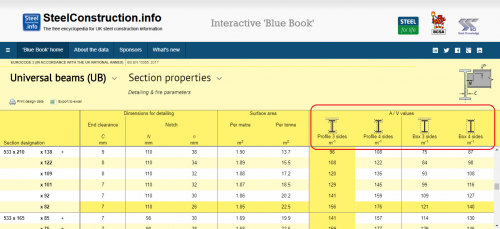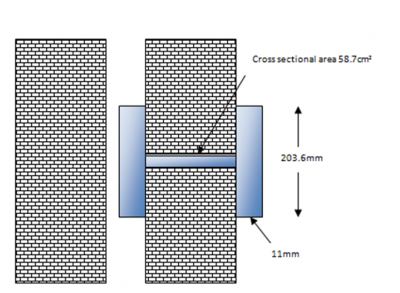Difference between revisions of "Calculating section factors"
| Line 55: | Line 55: | ||
The section factor is = 0.2256/58.7E-4 = 38.4m<sup>-1</sup>. | The section factor is = 0.2256/58.7E-4 = 38.4m<sup>-1</sup>. | ||
| − | Rounded to the nearest | + | Rounded to the nearest whole number, this is 38m<sup>-1</sup>. |
It should be noted that the calculation method in Table 4.2 of BS EN 1993-1-2<ref name="No1"> BS EN 1993-1-2. 2005, Eurocode 3. Design of steel structures. General rules. Structural fire design. BSI</ref> uses a more conservative value for the section factor as calculated by division of the exposed steel perimeter [A<sub>exp</sub>] by the exposed steel cross section area [V<sub>exp</sub>] rather than the entire volume of the steel section, despite the fact that heat is conducted into the entire volume of the steel section and also into the mass in contact with the embedded steel surface. | It should be noted that the calculation method in Table 4.2 of BS EN 1993-1-2<ref name="No1"> BS EN 1993-1-2. 2005, Eurocode 3. Design of steel structures. General rules. Structural fire design. BSI</ref> uses a more conservative value for the section factor as calculated by division of the exposed steel perimeter [A<sub>exp</sub>] by the exposed steel cross section area [V<sub>exp</sub>] rather than the entire volume of the steel section, despite the fact that heat is conducted into the entire volume of the steel section and also into the mass in contact with the embedded steel surface. | ||
| Line 63: | Line 63: | ||
For the purposes of this calculation, the section factor would be (0.2036+2*0.011/(0.2036*0.011)) = 100.7 | For the purposes of this calculation, the section factor would be (0.2036+2*0.011/(0.2036*0.011)) = 100.7 | ||
| − | Rounded to the nearest | + | Rounded to the nearest whole number, this is 101m<sup>-1</sup>. |
==References== | ==References== | ||
Revision as of 13:24, 30 April 2020
The section factor of a hot rolled open section, a hot finished/formed hollow section or fabricated girder is defined as the surface area of the member per unit length (Am) divided by the volume per unit length (V). It is measured in units of m-1. It is perhaps simpler to consider it as the heated perimeter of the exposed cross section (Hp) divided by the total cross-sectional area (A). These two definitions give the same answer for uniform cross-sections but the former is the manner in which it is referenced in the fire Eurocodes and which dominates most current literature. Section factors vary from 25m-1 for very large sections to over 300m-1 for small, slender sections.
[top]Calculation of section factors for exposed sections
Take the example of a hot rolled open section, a 533 x 210 UB 82 from The Blue Book. If this is exposed in fire on all four sides, the heated perimeter is given by:
Am = 2h + 4b + 2πr - 8r - 2tw
where h, b, r and tw are defined as shown to the right.
(2*528.3) + (4*208.8) + (π*12.7*2) – (8*12.7) – (2*9.6) = 1851mm or 1.851m
The cross-sectional area from The Blue Book is 105cm² or 105E-4m²
The section factor is therefore 1.851/105E-4 =176.3m-1
This is usually rounded up or down to the whole number. So the section factor is therefore 176m-1.
This is correct if the beam is unprotected or if the form of fire protection follows the profile, for example, a spray or an intumescent coating.
If the fire protection forms a box around the section, such as a board, then the heated perimeter becomes:
Am = (2h + 2b)
(2*528.3) + (2*208.8) = 1.474m and the section factor is 1.474/105E-4 = 140.4, or 140m-1 when rounded to the nearest whole number.
If the beam is carrying a concrete floor slab which shields the top flange, the heated perimeter for unprotected beams or beams with profile protection is:
Am = 2h + 3b + 2πr - 8r - 2tw
(2*528.3) + (3*208.8) + (π*12.7*2) – (8*12.7) – (2*9.6) = 1.642m
The section factor is therefore 1.642/105E-4 =156.4m-1. Rounded to the nearest whole number, this is 156m-1.
If the beam is carrying a concrete floor slab which shields the top flange, the heated perimeter for protection forming a box around the section is:
Am = (2h + b)
(2*528.3) + (208.8) = 1.265m
The section factor is therefore 1.265/105E-4 =120.5m-1. Rounded to the nearest whole number, this is 121m-1.
Section factors for the full range of open sections are calculated in the The Blue Book and are provided in the format shown.
[top]Calculation of section factors for partially exposed sections
Where sections are partially exposed, the section factor is calculated based on the full cross-sectional area but the exposed perimeter only. One of the most common situations where this occurs is with columns in perimeter walls. For the example shown, which is a 203 x 203 UC 46:
Heated perimeter = 203.6 + (11*2) = 225.6mm
The section factor is = 0.2256/58.7E-4 = 38.4m-1.
Rounded to the nearest whole number, this is 38m-1.
It should be noted that the calculation method in Table 4.2 of BS EN 1993-1-2[1] uses a more conservative value for the section factor as calculated by division of the exposed steel perimeter [Aexp] by the exposed steel cross section area [Vexp] rather than the entire volume of the steel section, despite the fact that heat is conducted into the entire volume of the steel section and also into the mass in contact with the embedded steel surface.
Thus, for partially exposed unprotected steel, the Eurocode section factor (Am/V) = (Aexp/Vexp).
For the purposes of this calculation, the section factor would be (0.2036+2*0.011/(0.2036*0.011)) = 100.7
Rounded to the nearest whole number, this is 101m-1.
[top]References
- ↑ BS EN 1993-1-2. 2005, Eurocode 3. Design of steel structures. General rules. Structural fire design. BSI
[top]Resources
- Steel construction - Fire Protection supplement, 2013
- SCI P363 Steel Building Design: Design Data, 2013
A web-based interactive version of the 'Blue Book', is also available.
[top]Further reading
- Fire protection for structural steel in buildings 5th edition (The Yelllow Book). Published by the Association for Specialist Fire Protection.






